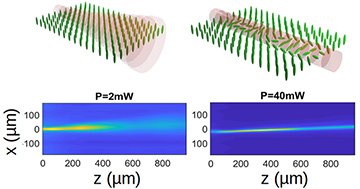 Power-dependent dynamics of beam and corresponding rotation of the optical axis inside a liquid crystal. Top left: Diffraction of low-power beam. Top right: Periodic rotation of optical axis by an impinging circular polarization results in beam confinement at high enough power. Bottom left and right: Experimental observations. [Enlarge figure]
Power-dependent dynamics of beam and corresponding rotation of the optical axis inside a liquid crystal. Top left: Diffraction of low-power beam. Top right: Periodic rotation of optical axis by an impinging circular polarization results in beam confinement at high enough power. Bottom left and right: Experimental observations. [Enlarge figure]
Pancharatnam-Berry geometric phase (PBGP) has recently attracted considerable interest, with advances in metasurface fabrication technologies bringing several innovative PBGP-based optical elements.1 The fundamental idea, originally due to Pancharatnam,2 is that polarization variations in anisotropic media can induce an additional phase, now called the PBGP, proportional to the local twisting angle of the material. The use of PBGP for wavefront manipulation has been revolutionary, resulting in flat, ultra-compact photonic devices such as planar lenses and deflectors, and giving a boost to the rapidly emerging field of metasurfaces. However, PBGP effects have not been used for distances larger than the Rayleigh length.
In 2016, a team including two of us proposed a novel waveguiding mechanism based solely on PBGP, requiring no refractive-index gradient as with traditional waveguides.3 This year, taking that work further, we have found that spatial self-localization can occur due to nonlinear modification of the PBGP.4 The self-modulation is driven by self-organization in the material (liquid crystals in our case) that originates from the strong light–matter interaction. We have now experimentally demonstrated, for the first time, a continuous optical waveguide based upon the geometric phase—an effect theoretically predicted in the linear regime in the 2016 study.3
Traditionally, the self-localization of waves is based upon the induction of a gradient in the dynamic phase experienced by the wave that is transverse with respect to the propagation direction. The basic difference in the approach used in our system leads to exotic and novel effects, and paves the way to the discovery of novel nonlinear interactions and phenomena. In fact, we have also shown that the interaction between distinct self-trapped waves depends strongly on the polarization. Using this unique property, both repelling and attracting interactions can be observed in the same sample, in full analogy with the Coulomb law for charged particles.
We believe that our system offers a unique platform for investigating nonlinear conversion between spin and orbital photonic angular momentum. Beyond optics, our results apply to any system encompassing spin–orbit interactions—for example, for the design of new kinds of electromagnetic traps, both for neutral and charged particles. In a far future, we envisage the realization of localized beams composed of electrons and photons, in which the electromagnetic field confines the electrons and the latter in turn generate the confining electromagnetic field in a purely nonlinear fashion.
Researchers
Chandroth P. Jisha and Alessandro Alberucci, Friedrich-Schiller-Universität Jena, Jena, Germany
Jeroen Beeckman, Ghent University, Ghent, Belgium
Stefan Nolte, Friedrich-Schiller-Universität Jena and Fraunhofer Institute for Applied Optics and Precision Engineering, Jena, Germany
References
1. P. Genevet et al. Optica 4, 139 (2017).
2. S. Pancharatnam. Proc. Indian Acad. Sci. A 44, 398 (1956).
3. S. Slussarenko et al. Nat. Photon. 10, 571 (2016).
4. C.P. Jisha et al. Phys. Rev. X 9, 021051 (2019).

